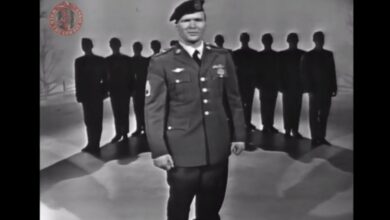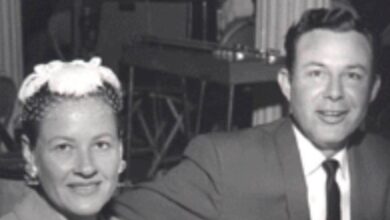Marty Robbins’ Most Cherished Version of “I Walk Alone”
Marty Robbins, who was born Martin David Robinson on September 26, 1925, in Glendale, Arizona, remains a pivotal figure in the history of American country music. His early life was steeped in the diverse sounds of his environment; Phoenix’s radio stations would often broadcast country music, cowboy tunes, and various populist genres, all of which shaped his musical identity. Robbins’s passion for music flourished as a child, and he often performed at local gatherings and school events. After World War II, where he served in the U.S. Navy, Robbins decided to pursue his musical aspirations earnestly, a decision that would lead to a remarkable career characterized by notable achievements and artistic growth.
Entering the music scene in the late 1940s, Robbins quickly gathered momentum and became recognized for his rich baritone voice. His ability to craft compelling narratives through lyrics set him apart from his contemporaries. The 1950s and 1960s marked a significant period in Robbins’s career as he released an array of hits that would become timeless classics. His song “El Paso,” for example, not only topped the charts but also showcased his knack for storytelling — weaving a narrative filled with longing, love, and tragedy that resonated with listeners across demographics. Such songs solidified his status as a key player in the evolving landscape of country music.
Robbins’s creative approach to songwriting was heavily influenced by his experiences. His life on the road, filled with both excitement and isolation, often inspired the themes of solitude and longing present in his work. “I Walk Alone,” released in 1968, exemplifies this where he delves into the emotional intricacies of life as a performer. The song conveys a poignant message about loneliness, echoing the experiences that many face when they dedicate their lives to the pursuit of art while balancing personal relationships. Robbins was adept at capturing the duality of public recognition and private isolation, a narrative that many artists contend with and one that his audience could deeply relate to.
Musically, “I Walk Alone” integrates traditional country elements with more contemporary sounds, reflecting Robbins’ willingness to evolve artistically. The song’s arrangement features a blend of fiddles and electric guitars, showcasing both the authenticity of country music roots and the innovations in sound processing that defined the era. This harmony of instruments complements Robbins’s emotive vocal style, ensuring that the song’s messages resonate with authenticity and depth.
Robbins’s legacy is underscored by his genre-crossing endeavors, which allowed him to appeal to a broader audience. His exploration of various musical styles, including rockabilly and folk, demonstrates his versatility as an artist. The intertwining of these genres enabled Robbins to carve a niche for himself while remaining authentic to his roots. His impacts can be seen in the works of later artists who cite him as an influence, emphasizing how his willingness to push musical boundaries paved the way for future generations.
The enduring popularity of “I Walk Alone” speaks volumes about Robbins’s artistry. Over the years, numerous artists have covered the song, reaffirming its significance within the music community. Its timeless message resonates with listeners, evoking emotions that transcend the decades. As societal contexts change, the lyrics maintain relevance, echoing sentiments of hope and introspection, proving the song’s adaptability and emotional depth.
During his illustrious career, Robbins garnered numerous accolades, including several Grammy Awards and recognition from the Country Music Association. His extensive catalog, consisting of over 500 recorded songs, illustrates not just a prolific career but also his dedication to the craft of songwriting. Tracks like “I Walk Alone” capture his unique storytelling approach, combining rich melodies with reflective lyrics that invite contemplation from the listener.
Robbins’s live performances were also a testament to his connection with fans. His ability to translate the emotional weight of his studio recordings into his stage presence was remarkable. Audiences were enchanted by his charisma and felt a sense of intimacy as he shared his life experiences through his music. The emotional crescendos in songs like “I Walk Alone” would resonate deeply in live settings, allowing fans to experience his artistry on multiple levels.
The themes that Robbins explored in his music, particularly in songs like “I Walk Alone,” speak to the essence of human experience. Loneliness, resilience, and longing are feelings that connect individuals across different walks of life, and Robbins captured these themes eloquently within the framework of country music. His work serves as a reminder of the significance of storytelling in song and its power to heal and touch listeners in profound ways.
Marty Robbins’s contributions to music, highlighted through the lens of songs like “I Walk Alone,” underscore not only his individual talent but also his lasting influence in the genre of country music. His ability to navigate complex emotions and translate them into words and melodies continues to resonate with audiences worldwide, ensuring that his legacy endures within the pantheon of great American musicians. His journey from Glendale, Arizona, to the heights of the music industry reflects a passion that inspires aspiring artists to pursue their dreams and convey their truths through song.





